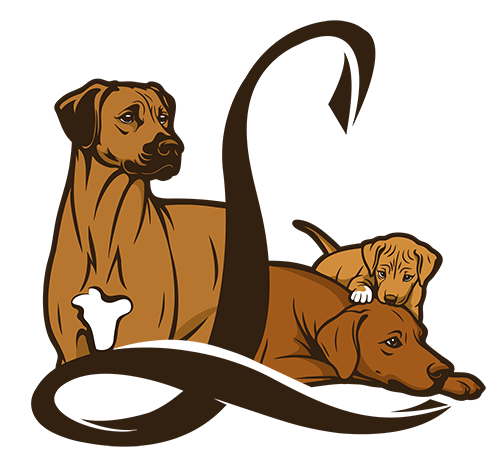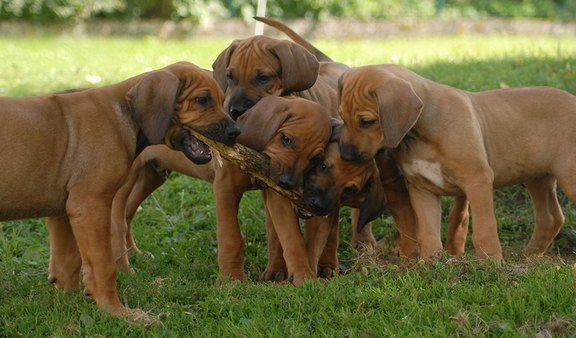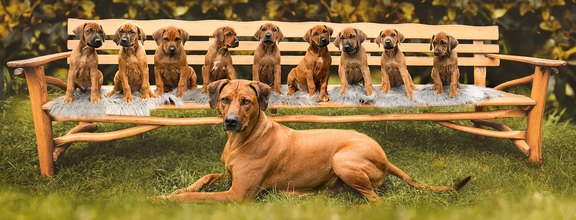Breeding the Lionhound

It makes sense to breed a breed in a club that sets out certain requirements and guidelines for breeding, keeps a stud book and forms a community dedicated to the welfare of the breed. There is now also a Club for the Lionhound, the
First Lionhound Club e.V.
The Club was registered on October 13, 2025 with the following board:
1st chairwoman: Monika Pehr
2nd chairwoman: Bianca Stöckl
Treasurer: Gesa Fischer
The website is currently under construction, but will take some time.
Anyone interested in becoming a member is welcome to contact the board members by phone or E-Mail:
Monika Pehr pehr@~@lionhound.org ; Phone.: +49 171-8382882
Bianca Stöckl. stoecklbianca@~@freenet.de ; Phone.: +49 176-23722556
Gesa Fischer gesa.m.fischer@~@gmx.de ; Phone.: +49 176-24044144
First, some information about breeding in First Lionhound Club e.V.

Breeding principles
The pedigrees of dogs of the Rhodesian Ridgeback breed are generally accepted for breeding. These dogs will only be issued an additional pedigree certificate (Takeover-Pedigree) with a new stud book number by the new club. These dogs are then entered in the stud book. In principle, Lionhound breeding initially runs parallel to Rhodesian Ridgeback breeding. This is intended to build up the breeding potential of the breed.
Dogs that have a breeding exclusion in the pedigree due to a cosmetic fault according to the Rhodesian Ridgeback standard (e.g. ridgeless, too much white....) have the opportunity to be used in breeding, as these cosmetic faults in the Lionhound do not preclude breeding. The prerequisite is, of course, that all health criteria and examinations in accordance with the breeding regulations are met.
The correct ridge plays absolutely no role in the Lionhound. In the long term, the aim is to use as few ridge-carrying dogs as possible in breeding. As there will certainly be a lack of breeding potential in ridgeless dogs at the beginning, mating of two dogs with a ridge is also possible in exceptional cases. However, this should be avoided and of course both breeding dogs must be heterozygous for the Ridge, i.e. have the R/r gene status. It is generally recommended that ridge-carrying dogs are only bred to ridgeless dogs in order to reduce the number of duplicated genes at the ridge gene locus. This should also reduce the risk of the Dermoid Sinus gene defect to a minimum and, in the long term, prevent the occurrence of Dermoid Sinus in the Lionhound.
X-ray examination
- Hip dysplasia (HD) - result: HD A or HD B
HD B may only be bred to HD A - Elbow dyplasia (ED) - Result: ED 0 or ED limit case
ED limit case may only be bred to ED 0 - Osteochondritis dissecans (OCD) - Result: OCD free or OCD transitional form
OCD transitional form may only be bred to OCD free - Lumbosacral transitional vertebra (LTV) - Result: Result: LTV 0 (free), LTV 1-2 (symmetrical), LTV 3 (asymmetrical), LTV 4 (L8)
There is still no scientific knowledge about the inheritance of LTV. It is recommended that dogs with LTV 1-4 should only be bred to LTV-free dogs.
Genetic testing
- Juvenile myoclonic epilepsy (JME)- Result: N/N (free) or JME/N (JME carrier)
JME carriers may only be bred to JME-free dogs - Degenerative myelopathy (DM) - Result: N/N (free) or DM/N (DM carrier)
DM carriers may only be bred to DM-free dogs - Early Onset Adult Deafnes (EOAD) - Result: N/N (free) or EOAD/N (carrier)
EOAD carriers may only be bred to EOAD-free dogs - Dilute (D) - Result: D/D or D/d (Dilute carrier)
Dilute carriers may only be bred to dilute-free dogs - Ridge (R) - Result: R/R, R/r or r/r (ridgeless)
Homozygous ridge carriers (R/R) may only be bred to ridgeless dogs with the genetic status r/r. Heterozygous dogs with ridge (R/r) should only be bred to ridgeless (r/r) dogs.
Genetic diversity
Due to strong line breeding, the genetic bottleneck becomes narrower and narrower. The coefficient of inbreeding (COI) and the ancestor loss coefficient (AVK) are now very high in many dogs and mating is often carried out in which numerous identical ancestors appear several times in the pedigree of both parents from the 3rd generation onwards. To counteract this, the maximum COI and AVK are prescribed.
The COI and AVK are calculated over 5 generations.
Ideally, the COI for a mating is 0% and the AVK is 100% (there are no common ancestors). The inbreeding coefficient (COI) should not be higher than 1% for a mating, it must not exceed a value of 3%. The recommended ancestor loss (AVK) is a maximum of 92% and must not be less than 80%.
The following dental faults are permitted, mating only with a breeding partner with full dentition:
Two missing P1 or one missing P2 or one missing P3
Breeding abroad
Breeders from abroad have the opportunity to be supervised by the FLC e.V. and obtain FLC pedigrees for their puppies. The breeder must be a member of the FLC, and the breeding bitch must have an FLC pedigree or a takeover pedigree.
For breeders from abroad, the same breeding requirements apply as for breeders breeding in Germany.
Breeders from abroad are responsible for complying with the legal breeding regulations of their country.

